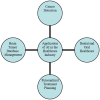Integrating artificial intelligence in healthcare: applications, challenges, and future directions
- PMID: 40616302
- PMCID: PMC12233828
- DOI: 10.1080/20565623.2025.2527505
Integrating artificial intelligence in healthcare: applications, challenges, and future directions
Abstract
Artificial intelligence (AI) has demonstrated remarkable potential in transforming medical diagnostics across various healthcare domains. This paper explores AI applications in cancer detection, dental medicine, brain tumor database management, and personalized treatment planning. AI technologies such as machine learning and deep learning have enhanced diagnostic accuracy, improved data management, and facilitated personalized treatment strategies. In cancer detection, AI-driven imaging analysis aids in early diagnosis and precise treatment decisions. In dental healthcare, AI applications improve oral disease detection, treatment planning, and workflow efficiency. AI-powered brain tumor databases streamline medical data management, enhancing diagnostic precision and research outcomes. Personalized treatment planning benefits from AI algorithms that analyze genetic, clinical, and lifestyle data to recommend tailored interventions. Despite these advancements, AI integration faces challenges related to data privacy, algorithm bias, and regulatory concerns. Addressing these issues requires improved data governance, ethical frameworks, and interdisciplinary collaboration among healthcare professionals, researchers, and policymakers. Through comprehensive validation, educational initiatives, and standardized protocols, AI adoption in healthcare can enhance patient outcomes and optimize clinical decision-making, advancing the future of precision medicine and personalized care.
Keywords: Artificial intelligence; brain tumour databases; cancer detection; dental healthcare; personalized treatment planning.
Plain language summary
This article explores how artificial intelligence (AI) is being used to improve healthcare. AI can analyze large amounts of data quickly, helping doctors detect diseases earlier, plan treatments more accurately, and manage patient records more efficiently. It is particularly useful in cancer diagnosis, dental health, brain tumor analysis, and personalized treatment planning. For example, AI tools can examine medical images to spot tumors or oral issues that may be missed by the human eye, and machine learning algorithms can suggest treatment options based on a patient’s unique history and health data. The study highlights successful applications of AI, such as using advanced image recognition to identify cancer, optimizing dental procedures, and improving brain tumor classification. Despite these benefits, challenges remain. These include concerns over data privacy, the fairness and transparency of AI decisions, the need for high-quality training data, and ensuring that medical professionals are trained to use AI effectively. The authors recommend stronger ethical guidelines, better education for healthcare workers, and improved validation of AI systems. With ongoing research and careful integration, AI has the potential to make healthcare more precise, efficient, and personalized, ultimately improving outcomes for patients and supporting doctors in delivering high-quality care.
Conflict of interest statement
The authors have no other relevant affiliations or financial involvement with any organization or entity with a financial interest in or financial conflict with the subject matter or materials discussed in the manuscript apart from those disclosed.
Figures

Similar articles
-
The impact of artificial intelligence on the endoscopic assessment of inflammatory bowel disease-related neoplasia.Therap Adv Gastroenterol. 2025 Jun 23;18:17562848251348574. doi: 10.1177/17562848251348574. eCollection 2025. Therap Adv Gastroenterol. 2025. PMID: 40556746 Free PMC article. Review.
-
A deep learning approach to direct immunofluorescence pattern recognition in autoimmune bullous diseases.Br J Dermatol. 2024 Jul 16;191(2):261-266. doi: 10.1093/bjd/ljae142. Br J Dermatol. 2024. PMID: 38581445
-
Shaping the Future of Dental Education: A Scoping Review of Artificial Intelligence (AI) Integration Strategies.Cureus. 2025 May 27;17(5):e84921. doi: 10.7759/cureus.84921. eCollection 2025 May. Cureus. 2025. PMID: 40575224 Free PMC article. Review.
-
Advancements in AI based healthcare techniques with FOCUS ON diagnostic techniques.Comput Biol Med. 2024 Sep;179:108917. doi: 10.1016/j.compbiomed.2024.108917. Epub 2024 Jul 25. Comput Biol Med. 2024. PMID: 39059212 Review.
-
The Role of Artificial Intelligence in Heart Failure Diagnostics, Risk Prediction, and Therapeutic Strategies: A Comprehensive Review.Cureus. 2025 Jul 1;17(7):e87130. doi: 10.7759/cureus.87130. eCollection 2025 Jul. Cureus. 2025. PMID: 40747166 Free PMC article. Review.
References
-
- Rao KS, Lean CP, Ng PK, et al. AI and ML in IR4.0: a short review of applications and challenges. Malaysian J Sci Adv Technol. 2024;4:141–148. doi: 10.56532/mjsat.v4i2.291 - DOI
-
- Rao KS, Lean CP, Yuan KF, et al. Transformative applications of IoT in diverse industries: a mini review. Malaysian J Sci Adv Technol. 2024;4:130–140. doi: 10.56532/mjsat.v4i2.292 - DOI
-
- Chong PL, Than YY, Ganesan S, et al. An overview of IoT based smart home surveillance and control system: challenges and prospects. Malaysian J Sci Adv Technol. 2023;4:54–66. doi: 10.56532/mjsat.v2iS1.121 - DOI
-
- Chong PL, Chuah JH, Chow C-O, et al. Plant microbial fuel cells: a comprehensive review of influential factors, innovative configurations, diverse applications, persistent challenges, and promising prospects. Int J Green Energy. 2024;22(3):599–648. doi: 10.1080/15435075.2024.2421325 - DOI
-
- Basir R, Islam GMN, Ng PK, et al. Exploring salary trends in data science, artificial intelligence, and machine learning: a comprehensive analysis. AIP Conference Proceedings. Vol. 3158; 2024. p. 020004. doi: 10.1063/5.0224376 - DOI
Publication types
LinkOut - more resources
Full Text Sources
